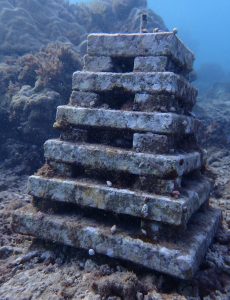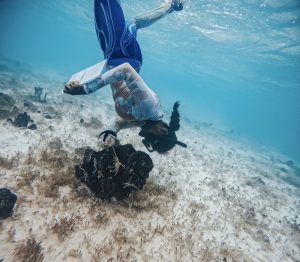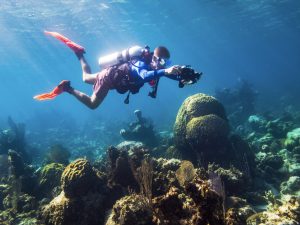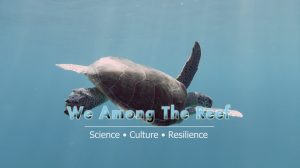The goal of the Fisheries Research and Conservation Program (FRCP) is “sustainable fisheries and healthy ecosystems that support biodiversity, livelihoods, ecosystems services and promote resilience”. Through applied conservation research, we work collaboratively with local and international scientists, government, fishers, non-governmental organizations and other key stakeholders to assess important fisheries, and to support the use of effective fishery policies and conservation actions for Bahamian marine resources.
One of these key resources is the Nassau grouper (Epinephelus striatus) – a highly valued and an important fishery species in The Bahamas and Caribbean. Based on what we know, almost all the reproduction or breeding for Nassau grouper occurs at annual fish spawning aggregations (FSAs). Unfortunately, the predictability of when and where FSAs occur means that Nassau grouper are extremely susceptible to overfishing.
Although The Bahamas possesses all the habitats used by groupers throughout their life history and most of the reported FSAs within the native range of this species, populations are in decline because many historic spawning sites have collapsed or have been drastically reduced due to FSA fishing.
To address this, the Perry Institute for Marine Science (PIMS) has been conducting research to monitor Nassau grouper and characterize the status of reported FSAs within The Bahamas. We use a variety of techniques to identify active spawning sites, monitor Nassau grouper abundance during and outside of the spawning season, map FSAs and understand how their populations are structured and connected throughout the archipelago. Collectively, these data provide valuable ecological information that are needed to inform sustainable management of this critically endangered species.
Thanks to the generosity of Mr. Wayne Sullivan, over the Christmas holidays, Dr. Krista Sherman (PIMS Senior Scientist), led a small research trip to survey an active Nassau grouper fish spawning aggregation (FSA) off Hope Town, Abaco. The team, comprised of Dr. Sherman, Dr. Valeria Pizarro and Michael Sherratt (PIMS) completed roving diver surveys to estimate abundances and sizes of Nassau grouper, and document and quantify spawning behaviour. Photographs and short video clips were also taken to assist with validating diver estimates.


Pictured: Left – Survey team just before a dive on Boxing Day (December 26, 2020) © Krista Sherman; Top right – Drs. Pizarro and Sherman surveying the Hope Town spawning aggregation © Michael Sherratt; and Bottom left – Dr. Sherman checking the status of the passive acoustic recorder being used to monitor sounds produced by Nassau grouper and identify the presence of other aggregating grouper species during the spawning season © Valeria Pizarro.
The Hope Town FSA, which is in a remote location, is relatively healthy — supporting thousands of Nassau grouper. This is good news for Nassau grouper and encouraging after documenting declines at several other historic FSAs over the past decade where aggregations either no longer form or have been drastically reduced (e.g. FSAs around Andros and Long Island).
Underwater video clip of aggregating Nassau grouper. © Valeria Pizarro
Preliminary diver estimates and observations also suggest that spawning occurs a few days before the full moon at this FSA, which differs from several other studied spawning sites within the Bahamian archipelago. Future assessments will be conducted to determine peak spawning months and abundance estimates and monitor the status of Nassau grouper stocks at this site.


Aggregating Nassau grouper at Hope Town, Abaco. © Krista Sherman, Perry Institute for Marine Science
In an extremely challenging year, it was truly a Christmas miracle that this research trip occurred, and the weather cooperated for us to complete surveys at the right time. Dr. Pizarro stated, “This was one of the best dives of my life. As a coral researcher this was an amazing experience and got me thinking of how healthy these aggregations were before overfishing”.
This research is extremely important because identifying and protecting healthy FSAs are not only critical for the survival of Nassau grouper, but also for the replenishment of the fishery, which provides income for local fishers and helps to feed communities. However, the fate of Nassau grouper and the future of the commercial fishery in The Bahamas will be shaped by our collective response to reduce FSA fishing and other threats that impede recovery for remaining populations. So please continue to support the CLOSED SEASON!
Tremendous thanks to Wayne Sullivan and the crew of the Glen Ellen for their hospitality and logistical assistance. Support for PIMS staff was provided by the Disney Conservation Fund through grants awarded to the Perry Institute for Marine Science.

December 2020 Nassau grouper research team from left to right: Michael Sherratt (PIMS), Wayne Sullivan (Glen Ellen), Dr. Valeria Pizarro and Dr. Krista Sherman (PIMS). © Krista Sherman, Perry Institute for Marine Science
For more information about Nassau grouper and FSA research and to support work under the FRCP visit our website and follow Facebook and Instagram at @perryinstituteformarinescience and @nassaugrouper242.

Unveiling Coral Reef Biodiversity: Insights from ARMS Monitoring Structures
An ARM teeming with new coral recruits and a diversity of marine life, highlighting reef recovery and biodiversity Understanding Coral Reef Biodiversity Most new PhDs

7 Essential Insights from COP16: Tackling Coral Reef Conservation Challenges Amid Climate Change
United #ForCoral: Experts, advocates, and leaders from across the globe join forces at COP16 for the #ForCoral conference, hosted by the International Coral Reef Initiative.

Fieldwork Wrap-Up: Strengthening MPA Management in The Bahamas
Marine protected areas (MPAs) are critical tools in the conservation of marine species and habitats, safeguarding reefs, seagrasses, and mangroves that provide vital ecosystem services

Coral Reef Monitoring with Photogrammetry: A New Era in Reef Health Assessment
Coral reefs are some of the most biodiverse ecosystems on the planet, providing crucial habitat for marine life and protecting coastal regions from erosion. Yet,

Watch “We Among the Reef:” A Documentary on the Abaco Barrier Reef
The Perry Institute for Marine Science invites you to watch “We Among the Reef,” a compelling documentary that illuminates the significance of the Abaco Barrier

Guardians of the Deep: With Training from PIMS, Key Government Staff Become PADI Certified Divers
Akehia Thompson (DMR), Quetta Gibson (DMR), and Gilles Deal (DEPP) share a moment of camaraderie in their scuba gear, embarking on their training journey with




